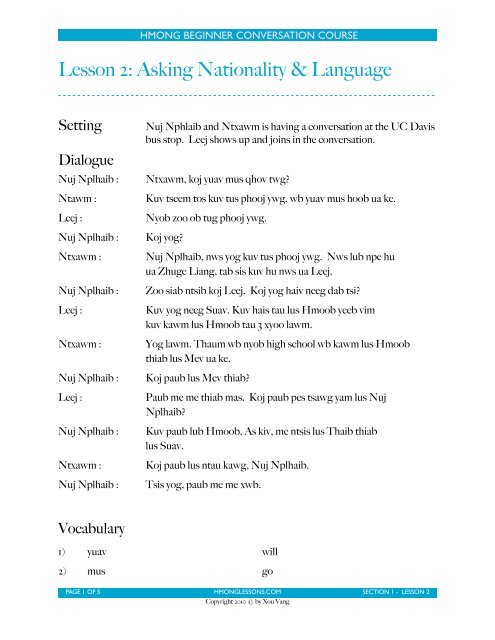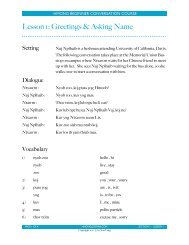BC Lesson 2 - learn hmong lessons & traditions
BC Lesson 2 - learn hmong lessons & traditions
BC Lesson 2 - learn hmong lessons & traditions
Create successful ePaper yourself
Turn your PDF publications into a flip-book with our unique Google optimized e-Paper software.
<strong>Lesson</strong> 2: Asking Nationality & Language<br />
Setting Nuj Nphlaib and Ntxawm is having a conversation at the UC Davis<br />
bus stop. Leej shows up and joins in the conversation.<br />
Dialogue<br />
Nuj Nplhaib : Ntxawm, koj yuav mus qhov twg?<br />
Ntawm : Kuv tseem tos kuv tus phooj ywg, wb yuav mus hoob ua ke.<br />
Leej : Nyob zoo ob tug phooj ywg.<br />
Nuj Nplhaib : Koj yog?<br />
Ntxawm : Nuj Nplhaib, nws yog kuv tus phooj ywg. Nws lub npe hu<br />
ua Zhuge Liang, tab sis kuv hu nws ua Leej.<br />
Nuj Nplhaib : Zoo siab ntsib koj Leej. Koj yog haiv neeg dab tsi?<br />
Leej : Kuv yog neeg Suav. Kuv hais tau lus Hmoob yeeb vim<br />
kuv kawm lus Hmoob tau 3 xyoo lawm.<br />
Ntxawm : Yog lawm. Thaum wb nyob high school wb kawm lus Hmoob<br />
thiab lus Mev ua ke.<br />
Nuj Nplhaib : Koj paub lus Mev thiab?<br />
Leej : Paub me me thiab mas. Koj paub pes tsawg yam lus Nuj<br />
Nplhaib?<br />
Nuj Nplhaib : Kuv paub lub Hmoob, As kiv, me ntsis lus Thaib thiab<br />
lus Suav.<br />
Ntxawm : Koj paub lus ntau kawg, Nuj Nplhaib.<br />
Nuj Nplhaib : Tsis yog, paub me me xwb.<br />
Vocabulary<br />
HMONG BEGINNER CONVERSATION COURSE<br />
1) yuav will<br />
2) mus go<br />
PAGE 1 OF 5 HMONGLESSONS.COM SECTION 1 - LESSON 2<br />
Copyright 2010 © by Xou Vang
HMONG BEGINNER CONVERSATION COURSE<br />
3) qhov twg where<br />
4) tseem tos still waiting<br />
tos wait , to wait<br />
5) tus , tug classifier for people, animal, long objects<br />
6) phooj ywg friend<br />
7) wb we , us , you and I<br />
8) hoob class , room<br />
9) ua ke together<br />
10) ob (2) tug 2 , two person<br />
11) nws he, him , his<br />
12) tab sis but<br />
13) haiv neeg nationality , race<br />
haiv nation , nationality<br />
neeg people , person<br />
14) dab tsi what , question particle<br />
15) hais lus speak , to speak , spoken<br />
16) lus language , word , speech<br />
17) yeeb vim because<br />
18) kawm <strong>learn</strong> , to <strong>learn</strong><br />
19) tau peb (3) xyoo lawm for 3 years already<br />
20) 3 (peb) 3 (three)<br />
21) xyoo year<br />
22) lawm particle indicating completion of action<br />
23) yog lawm that’s right , yes<br />
24) thaum when<br />
25) paub know , to know<br />
26) me me little , small<br />
PAGE 2 OF 5 HMONGLESSONS.COM SECTION 1 - LESSON 2<br />
Copyright 2010 © by Xou Vang
me ntsis a little<br />
27) pes tsawg how many , how much<br />
28) yam kind<br />
29) ntau kawg a lot , very much<br />
ntau a lot , much<br />
kawg particle measuring extremity<br />
30) tsis yog (tsi yog) no , it’s not right<br />
tsis (tsi) no<br />
31) me me xwb only a little<br />
32) xwb only<br />
Pronouns:<br />
HMONG BEGINNER CONVERSATION COURSE<br />
33) Zhuge Liang Chinese personal name<br />
34) Leej Hmong personal name<br />
35) Suav Chinese<br />
36) Mev Spanish , Mexican<br />
37) As kiv English<br />
38) Thaib Thai<br />
Helpful and Interesting Notes<br />
1) The two words “tus” and “tug” are classifier for people, animal, and certain object,<br />
mainly long shape objects. “tus” is used to show ownership of people, animal,<br />
certain object. “tug” is a classifier used for people, animal, or certain object when it<br />
does not classify who it belong to.<br />
Ex. Kuv tus phooj ywg - My friend<br />
Nws tus miv - His cat.<br />
Wb tus choj - Our bridge.<br />
Ob tug phooj ywg - Two friends.<br />
PAGE 3 OF 5 HMONGLESSONS.COM SECTION 1 - LESSON 2<br />
Copyright 2010 © by Xou Vang
Ob tug dev thiab tug miv - Two dogs and two cats.<br />
Tug neeg Suav - The Chinese person.<br />
2) The word “dab tsi” means what. But having “dab tsi” at the end of a word or a<br />
sentence, turns the word or sentence into a question.<br />
Ex. Yog dab tsi? - What is it?<br />
Koj kawm dab tsi ne? - You are <strong>learn</strong>ing what?<br />
Nws hias lus dab tsi? - What language is he/she speaking?<br />
3) The particle “lawm” 1) signifies the occurrence or completion of an action or event,<br />
or 2) the emergence of a situation. The action, event, or situation usually pertains<br />
to the past, but can sometimes refer to the future. Therefore “lawm” is not a past<br />
tense marker and is not equivalent to the past tense in English.<br />
Ex. Nws mus qhov twg lawm? - Where did he/she go?<br />
Kuv paub me me lawm. - I know a little now.<br />
Wb yuav tsis mus lawm. - We will not go anymore.<br />
4) The word “kawg” literally means end or to end. Using “kawg” after an adjective<br />
makes the adjective more extreme. In a way, it can be used as the word “very” in<br />
english. For example, very good means zoo kawg and very true means yog kawg.<br />
Ex. Nws hais lus Hmoob zoo kawg! - He/She speak Hmong very well!<br />
Koj mus los tau kawg! - You can go!<br />
5) Using “tsis or tsi” in front of a verb or adjective makes it negative or opposite to the<br />
original word. For example, “yog” means yes, but adding “tsis or tsi” in front of<br />
“yog” means no.<br />
Ex. Koj puas tau hais. - Did you said? Kuv tsis tau hais. - I did not said.<br />
Nws tsi yog kuv tus phooj ywg. - He is not my friend.<br />
Translation of Dialogue<br />
HMONG BEGINNER CONVERSATION COURSE<br />
Nuj Nplhaib : Ntxawm, where are you going?<br />
Ntawm : I am still waiting for my friend, we are going to class together.<br />
PAGE 4 OF 5 HMONGLESSONS.COM SECTION 1 - LESSON 2<br />
Copyright 2010 © by Xou Vang
Leej : Hello friends.<br />
Nuj Nplhaib : You are?<br />
Ntxawm : Nuj Nplhaib, he is my friend. His name is Zhuge Liang, but I<br />
called him Leej.<br />
Nuj Nplhaib : I am happy to meet you Leej. What nationality are you?<br />
Leej : I am Chinese. I can speak Hmong because I <strong>learn</strong>ed<br />
Hmong for three years already.<br />
Ntxawm : That’s right. When we were in high school, we <strong>learn</strong>ed Hmong<br />
and spanish together.<br />
Nuj Nplhaib : You know spanish too?<br />
Leej : Just a little. How many language do you speak, Nuj Nplhaib?<br />
Nuj Nplhaib : I know Hmong, English, and a little of Chinese and Thai.<br />
Ntxawm : You know a lot, Nuj Nplhaib.<br />
Nuj Nplhaib : Only a little.<br />
Progress Check<br />
After finishing this lesson, you should be able to<br />
Ask where someone is going.<br />
Ask someone’s nationality.<br />
Ask and answer how many language you or someone speak.<br />
* When you are able to do the above, move on to lesson 3! If you are still having trouble,<br />
review the lesson until you fully understand all the vocabularies and the dialogue.<br />
Total New Words: 38<br />
Total Words: 60<br />
HMONG BEGINNER CONVERSATION COURSE<br />
Next <strong>Lesson</strong> : Asking Age & Residence<br />
PAGE 5 OF 5 HMONGLESSONS.COM SECTION 1 - LESSON 2<br />
Copyright 2010 © by Xou Vang



